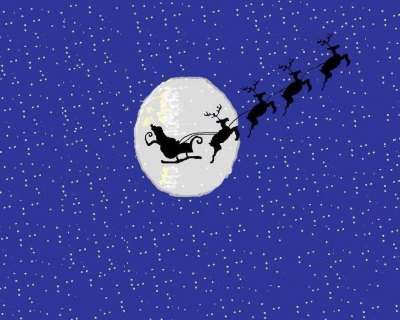Cartoon Truth:
The 'Night Before Christmas' author on trial

The child’s poem, Twas the Night Before Christmas or A Visit from St. Nicholas, gave the world its image of Santa, and the credited author is Clement Clarke Moore. But some scholars say that Moore didn't write the classic. The author, they argue, was Henry Livingston Jr.
It’s serious business in New York. Livingston was from Poughkeepsie in the Hudson Valley area. Moore was from New York City. A mock trial was held in Troy earlier this month to settle the matter. The verdict: Livingston wrote the poem.
This is all fodder for a classic dining-room discussion, the sort that goes on for hours and ends nowhere, but it's not as bad as arguing over politics.
Here are the talking points:
- About Moore: Born in New York City, Moore, (1779-1863) was the son of Charity Clarke Moore and the Rev. Benjamin Moore, a president of Kings College (Columbia University). Clement Clarke Moore was a wealthy developer, philanthropist and professor at New York’s General Theological Seminary. His writings included poetry, a historical biography and the two-volume A Compendious Lexicon of the Hebrew Language (1809), according to the Poetry Foundation.
- About Livingston: Like Moore, Livingston (1748–1828) was from a prominent family. He came of age during the American Revolution and joined the Continental Army, serving as a major. (Articles often refer to him as "Maj. Livingston.") He was also a farmer, surveyor and justice of the peace, according to the Poetry Foundation. His first wife died in 1783, and 10 years later he remarried.
- A Visit from St. Nicholas was first told before dinner on Christmas, 1822: The story goes that Moore wrote A Visit from St. Nicholas while on an errand to get a Christmas turkey. He recited it to his family on Christmas, 1822. A house guest copied the poem and submitted it for publication to The Troy Sentinel, which published it anonymously in 1823. An editor republished it – giving Moore credit – in 1836. Moore didn’t ask the editor for a correction or disassociate himself from the poem. In 1844, Moore published a book of poems in which he took credit for the work.
- A Visit from St. Nicholas was first told over breakfast on Christmas, 1808: As told by Livingston’s children and grandchildren, Maj. Livingston first recited the Santa story during breakfast on Christmas morning, 1808, according to Author Unknown, On the Trail of Anonymous, (Henry Holt; 2000) by Don Foster, a Vassar College English professor.
- Small town/Downtown: Livingston’s mother was Dutch, and he was from an area of New York where Christmas was celebrated in the Dutch fashion. In his book, Foster writes, “The children of Manhattan knew nothing of stockings hung by the chimney with care, and nothing (thank God!) of a pipe-smoking saint. There were no nighttime miracles causing cookies and knick-knacks to appear as if out of the blue— except, of course, upriver, in quaint villages like Fishkill, Poughkeepsie and Sleepy Hollow, where Dutch Americans, though warned from Episcopal and Presbyterian pulpits, would and did hang their stockings by the fire.”
- Type A personality: The tone of Twas the Night Before Christmas is whimsical. St. Nicholas is a jolly elf who leaves gifts. Livingston proponents argue that this might have been out of character for Moore. In 1836, Washington Irving and Gulian Verplanck proposed starting a Saint Nicholas Society to hold an annual banquet and collect gifts for the poor, recounts Foster in Author Unknown. Moore wanted no part of it. Foster wrote that from Moore's point of view, "Christmas was no time to be jolly, but a season for worship, for repentance from sin."
- Type B personality: Livingston wrote this: "Such gadding— such ambling— such jaunting about! To tea with Miss Nancy— to sweet Willy’s rout, New parties at coffee—then parties at wine, Next day all the world with the Major must dine!"
- A matter of style: Twas the Night Before Christmas was written in rhyming anapests. Livingston’s descendents point out that Henry Livingston often wrote this way. Moore did not. The website henrylivingston.com offers a letter by MacDonald P. Jackson, a professor emeritus of English at the University of Auckland, New Zealand, who analyzed Livingston's writing and concluded that 'Twas the Night Before Christmas associates more with Livingston's writing than Moore's.
- Put it in writing: If Livingston was the author, his copy of the poem has been lost. He never specifically claimed the poem belonged to him. Proponents of Moore point out that the only known copies of the poem are in Moore's handwriting.
- Blixem, Blixen, Blitzen…whatever: In the 1823 version, Santa calls out to his reindeer this way: “On! Comet, on! Cupid, on! Dunder and Blixem.” In his book, Foster points out that “Dunder” and “Blixem” are actually Dutch oaths. “Dunder and Blixem” translates: thunder and lightning! Livingston would have known this. An editor changed the names to Donder and Blixen later. In 1844, Moore changed Blixem’s name to Blitzen and later autographed a manuscript with the spelling Blitzen, indicating that he “did not know the original names of his own Dutch reindeer,” Foster writes.
See this and other animations on our sister website, cartoontruth.com.
Resources:
Website about Henry Livingston Jr.
Poetry Foundation article about Clement Clarke Moore
Trial Before Christmas on vimeo.com
A good book on the subject:
Author Unknown: On the Trail of Anonymous by Don Foster (Henry Holt; 2000)

